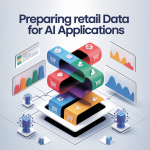
Understanding Artificial Intelligence: Foundations and Significance
Artificial Intelligence has been around for some time, but it has received a major boost lately due to significant developments in both the technology itself and in computing power.
AI requires a tremendous amount of computing power because it processes millions and millions of data sets. That’s how it operates.
Artificial intelligence improves as more data is fed into it—the better the data, the better the results. Let’s not forget, though: this is still a computer system.
The old saying, “Garbage in, garbage out,” absolutely applies here. If your data is poor, you can’t expect good outcomes from artificial intelligence.
That’s why it’s critical to ensure your data is clean and well-organized.
Even if you haven’t been keeping proper data sets up until now, start immediately.
You’ve been in business for some time and you’re going to need AI sooner or later—whether in a few months or a few years.
The bottom line is that artificial intelligence is here to stay. It provides a serious competitive advantage.
Those who use it effectively will move ahead, while others will be left behind.
Now, the backstage of this technology is extremely complex. I worked in an AI company for a couple of years as Vice President of Sales and Marketing.
The environment was more like a university than a company, because most of our employees held PhDs in mathematics and statistics.
That’s the level of complexity we’re talking about. These professionals were developing algorithms to solve the issues brought forward by retailers.
Based on that input, they coded the software—complex algorithms that most of us wouldn’t even begin to understand.
And we don’t need to understand those algorithms. What we need to do is use the system effectively—just like using Microsoft Excel.
You enter the inputs, and Excel runs its algorithm to give you the output.
Now imagine AI as a million times more complex than Excel, but still accessible to you as a user.
You input your business data, and AI will give you the results you need.
Let’s remember, different AI companies develop their own algorithms. That means there will be variations in the accuracy and effectiveness of their systems.
Just like with any technology purchase, it’s important to assess the quality, experience, and references of the provider.
What I’m going to do next is give you a basic understanding of the technologies that make up artificial intelligence.
That way, when we talk about retail applications, you’ll have some technical context. Not much—just a little—because the rest is extremely complex.
What Does Artificial Intelligence Actually Do?
At its core, artificial intelligence analyzes mountains of data. It classifies the data, identifies patterns, and learns from them.
Modern AI doesn’t just analyze numbers—it can also interpret images, understand text, and draw meaningful conclusions based on the data it’s given.
For example, you might ask a process-related question like, “How many units of this item am I going to sell next month?”
AI will look back at historical sales patterns and return a prediction based on that analysis. The more data you provide, the more accurate the prediction will be.
Humans can do this too—but not at this scale. The amount of data AI processes would take human analysts years to sort through. AI does it in seconds.
Machine Learning: The Core of AI
Machine learning is a subset of AI that enables computer systems to automatically learn and improve from experience without being explicitly programmed.
These systems develop algorithms that analyze data and make predictions.
Let’s say you ask, “What’s the weather going to be like tomorrow?” The AI system pulls data from thousands of weather stations, processes it, and provides an answer.
Then, the next day, it compares its prediction with the actual weather. If there’s a gap, it learns from that mistake. Over time, its predictions get more accurate.
That’s machine learning: constant improvement through experience and data.
Deep Learning and Neural Networks
A more advanced version of machine learning is called deep learning, which uses neural networks.
These are modeled after the human brain, where interconnected neurons process and transmit information.
Neural networks allow the system to process extremely complex patterns.
For instance, if you want the system to recognize pictures of cats, you feed it thousands of cat images.
Once trained, you can show it a new image, and it will say, “Yes, that’s a cat,” or “No, that’s not,” based on what it’s learned.
Neural networks are the backbone of deep learning and allow machines to make decisions in ways that mimic human thinking—except much faster.
Cognitive Computing: Thinking More Like Humans
Now we’re getting even more sophisticated. Cognitive computing introduces human-like understanding into the system.
Until now, AI just looked at data patterns and gave answers. With cognitive computing, AI can begin to “understand” the meaning behind those patterns.
These are separate sets of algorithms—almost like different software tools—for different purposes.
Depending on the problem you’re trying to solve, one or more of these tools might be used at the same time.
Natural Language Processing (NLP): Understanding Language
Natural language processing allows AI to understand and respond to human language—spoken or written. You’ve likely heard of ChatGPT.
It’s a prime example of NLP in action. You can ask it to write an article, answer a question, or even hold a conversation.
It sounds like a person because it understands the context and structure of language.
ChatGPT and other NLP systems operate using incredibly powerful language models that enable back-and-forth interaction in a natural way.
Computer Vision: Understanding Images
Another major advancement is in computer vision—the ability of AI to understand images.
Right now, search engines like Google can’t fully interpret what’s in a JPEG image on your website. That’s why we add “alt text” to describe it. But AI is changing that.
With advanced computer vision, AI can now recognize what’s in an image—whether it’s a product, a face, or even a brand logo. This capability is evolving fast.
Soon, AI will be able to scan social media platforms and recognize your company’s visuals even without being tagged.
It’s a huge leap forward. And it’s already starting to happen.


